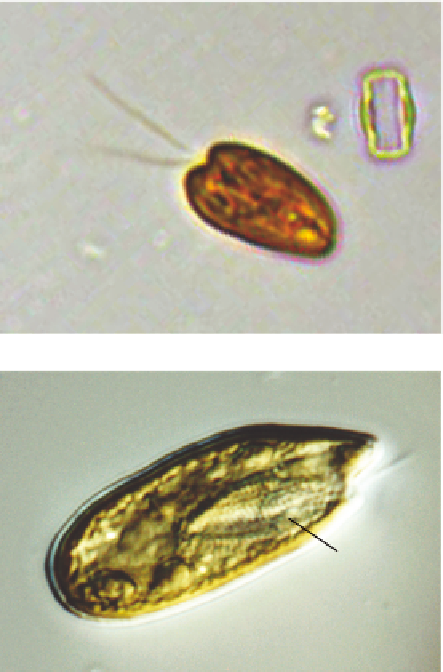Environmental Engineering Reference
In-Depth Information
Planktonic, in ponds and shallow waters.
Cryptophyta. Plate XVI.
(b) Gullet present, chloroplasts brown to
olivegreen...............
Cryptomonas
Cells of
Cryptomonas
(up to 80 μmin
length, 26 μm wide) are slipper- to bean-
shaped with some dorsiventral flattening.
They have two nearly equal flagella, one
or two reddish-brown chloroplasts (with
up to four pyrenoids) and a conspicuous
gullet extending as a longitudinal furrow
from the anterior end. Free swimming in
the plankton. Widespread and sometimes
in large numbers, when it may impart an
odour to drinking water (Palmer, 1962).
Cryptophyta. Plate XVI. Fig. 4.53.
10 μm
121
(118) (a) Chloroplast in centre of cell, sus-
pended there by strands of cytoplasm
.......................
Haematococcus
Cells of
Haematococcus
(sometimes
called
Sphaerella
) are oval to spherical,
8-30 μm in diameter, and have a thick
mucilaginous wall. The green pigments in
the chloroplast are often masked with red
haematochrome so that the cells, partic-
ularly in the encysted state, appear red.
The cup-shaped chloroplast has one to
four pyrenoids and appears attached to the
cell wall by cytoplasmic strands. Occurs
in small water bodies and snow as well
as bird baths which it may colour red.
Chlorophyta. Plate XVI. Fig. 4.54.
20 μm
Figure 4.53
Cryptomonas.
Top: Small reddish brown,
slipper-shapedbilagellatecell.Reproducedwithpermis-
sion from G. Ji. Bottom: Large olive-green cell showing
conspicuous anterior gullet (arrow). Reproduced with
permission from R. Matthews. Separate species.
like extensions of the cell wall giving
the cells an angular appearance. The cells
are rounded but flattened in side view.
A cup-shaped chloroplast is present with
one to many pyrenoids.
Pteromonas
is
widespread in its occurrence but generally
prefers nutrient-rich waters, either ponds
or slow rivers. Plate XVI.
(b) Chloroplast not attached to the cell
wall by means of cytoplasmic strands
..................................
122
122
(121) (a) Cells with hyaline wing around the
cell but most prominent on either side
..........................
Pteromonas
(b) Cells without hyaline wing
....................
Chlamydomonas
Pteromonas
cellshavetwolagellaemerg-
ing from the anterior end, with wing-
Chlamydomonas
is a very large
genus with numerous species. Widely




Search WWH ::

Custom Search